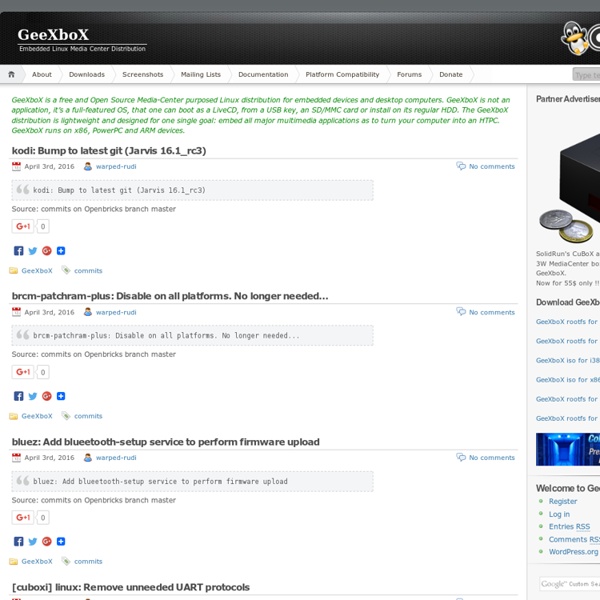GeeXboX
Un article de Wikipédia, l'encyclopédie libre. GeeXboX est un live CD léger (environ 136 Mo) basé sur Linux et MPlayer. Il permet de transformer (presque) n'importe quel ordinateur en véritable media center.
About
XBMC is an award-winning free and open source (GPL) software media player and entertainment hub that can be installed on Linux, OSX, Windows, iOS, and Android, featuring a 10-foot user interface for use with televisions and remote controls. It allows users to play and view most videos, music, podcasts, and other digital media files from local and network storage media and the internet. Our forums and Wiki are bursting with knowledge and help for the new user right up to the application developer.
Which Media Center Is Right for You: Boxee, XBMC, and Windows Media Center Compared
@Nitesh Singh: I'd kind of like to know as well. I could easily see it being an issue with ATI being stingy with access to its drivers as they have in the past, but at the same time, I wouldn't put it past Nvidia to put down a little financial pressure to keep things one-sided. @acceptablerisk: What's up with the conspiracy theories? XMBC is open source, that pretty much excludes any financial gain from supporting only Nvidia... @minivolt: Oh, I suspect it's much more along the lines of Nvidia being more open about access to their drivers and APIs than about anything underhanded. On projects like this it's probably not even worth their time (or in the case of XBMC, it's completely improbable) to cut out other players.
Welcome to Tiny Core Linux
Welcome, from the Tiny Core development team. This is a brief introduction to Tiny Core, a unique and minimalist distribution of the Linux operating system and tools. Experienced Linux users won't miss much by skipping straight to the Core Concepts page. To find out if Tiny Core is the right distribution for you, this document starts at ground zero and says what Tiny Core is not. A few key features follow, and then the page wraps up with links to further reading, where to get Tiny Core, and where to find help.
Fedora - Distributions GNU/Linux
Basée sur le projet communautaire Fedora et sponsorisée par Red Hat (qui a abandonné la diffusion pour le grand public afin de se recentrer sur les entreprises), la distribution [1] Gnu/Linux Fedora s’adresse au grand public. L’installation L’installation de Fedora se déroule grâce à une interface graphique très bien réalisée. On vous propose une sélection des logiciels à installer en fonction de l’utilisation que vous souhaitez faire de votre ordinateur (ordinateur personnel, de bureau, serveur, ... ). Bien entendu vous pouvez toujours sélectionner les logiciels un par un afin de vous faire un système aux petits oignons si vous savez ce que vous souhaitez exactement.
GeeXboX uShare UPnP A/V Media Server HomePage
MEDIAPORTAL - a HTPC Media Center for free!
BasicLinux
BasicLinux BasicLinux is designed specifically for old PCs. It uses a small kernel and busybox to provide a low-RAM Linux, capable of browsing the web, doing email, and functioning as an X terminal. The current release of BasicLinux is particularly suitable for old laptops -- it has PCMCIA capability and includes MagicPoint (a presentation tool similar to PowerPoint).
Kubuntu Linux - Distributions GNU/Linux
Kubuntu est une distribution GNU/Linux, dérivée du très répandu Ubuntu, la réelle différence entre ces deux distributions résidant dans le choix de l’environnement par défaut, en effet Ubuntu utilise l’environnement Gnome, alors que Kubuntu utilise KDE. Mêmesi, avant la sortie de Kubuntu, il était déjà possible d’installer l’environnement KDE sur Ubuntu, une telle installation aboutissait à quelques imperfections contrariantes à l’usage. De plus il était parfois impossible d’installer aisément des logiciels KDE. Désormais, l’équipe Ubuntu propose le support de KDE à travers le sous-projet Kubuntu. Tous les paquetages sont issus des mêmes archives que celles d’Ubuntu Linux.




Open source media center, also on Panda board... by ocpourvoir Oct 17